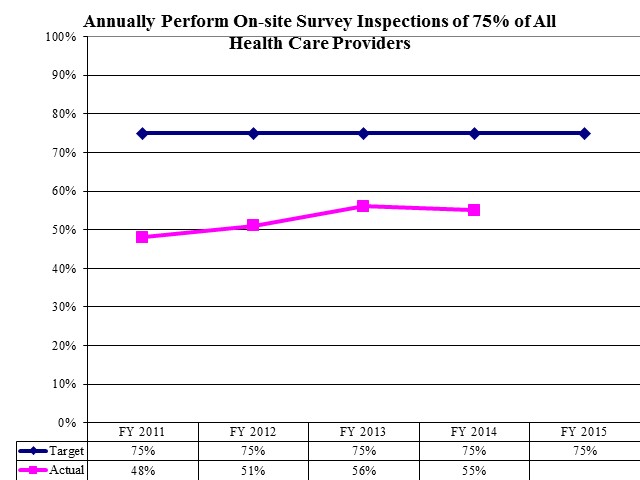The Bureau of Health Facility Licensing and Certification has the responsibility for licensing and inspection of healthcare facilities including hospitals, nursing homes, Intermediate Care Facilities for Individuals with Intellectual Disabilities, home health agencies, assisted living facilities and other provider types. Licensing is required to operate a health facility in Utah, and also serves to meet federal requirements for certification for Medicare/Medicaid programs. The Bureau also investigates complaints made about these providers. The licensing rules for health facilities can be found in the Utah Administrative Code R432.
During the 2015 General Session, the Legislature appropriated for Fiscal Year 2016, $5,725,100 from all sources for Health Facility Licensing and Certification. This is a 19.2 percent reduction from Fiscal Year 2015 revised estimated amounts from all sources. The total includes $1,361,000 from the General/Education Funds, an increase of 11.5 percent from revised Fiscal Year 2015 estimates.
In addition to statewide compensation and internal service fund cost increases, the following appropriation adjustments were made during the 2015 General Session:
The Bureau performs background screening for all staff that have direct access to patients of all nursing homes, small health care facilities, assisted living facilities, home health agencies, hospice agencies, long term acute care hospitals, and end stage renal disease facilities. About 5% of checks result in denials based on criminal findings.
The Bureau is responsible to certify any health facility that wants to participate in the Medicare and/or Medicaid programs. Some of the health facilities that choose to participate are hospitals, home health agencies, surgery centers, nursing facilities, and hospice programs.
The Bureau also reviews building plans for new construction and remodeling of health care facilities. Some of the building design and construction requirements for health care facilities that are much more stringent than private structures include: ventilation systems, sprinkler systems, size of hallways, access and egress points, adequacy of plumbing, emergency power supplies, and others.
The Bureau is responsible for managing two federal grants: Title 18 (Medicare) Certification Grant and Title 19 (Medicaid) Certification. These grants have different federal matching rates. Title 18 Certification is 100 percent federally-funded and Title 19 is matched at either 75 percent or 50 percent Federal Financial Participation. In addition, the Bureau participates in the regular Title 19, general Medicaid administration program. This program is matched at 75 percent or 50 percent Federal Financial Participation. Overall, the average match rate is 87.5 percent federal and 12.5 percent State.
The monthly caseload is the number of health care facilities inspected.
COBI contains unaudited data as presented to the Legislature by state agencies at the time of publication. For audited financial data see the State of Utah's Comprehensive Annual Financial Reports.
